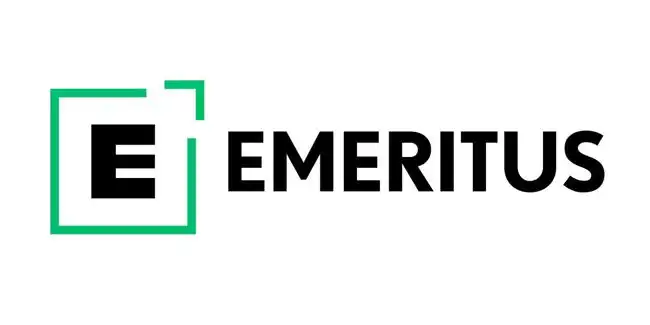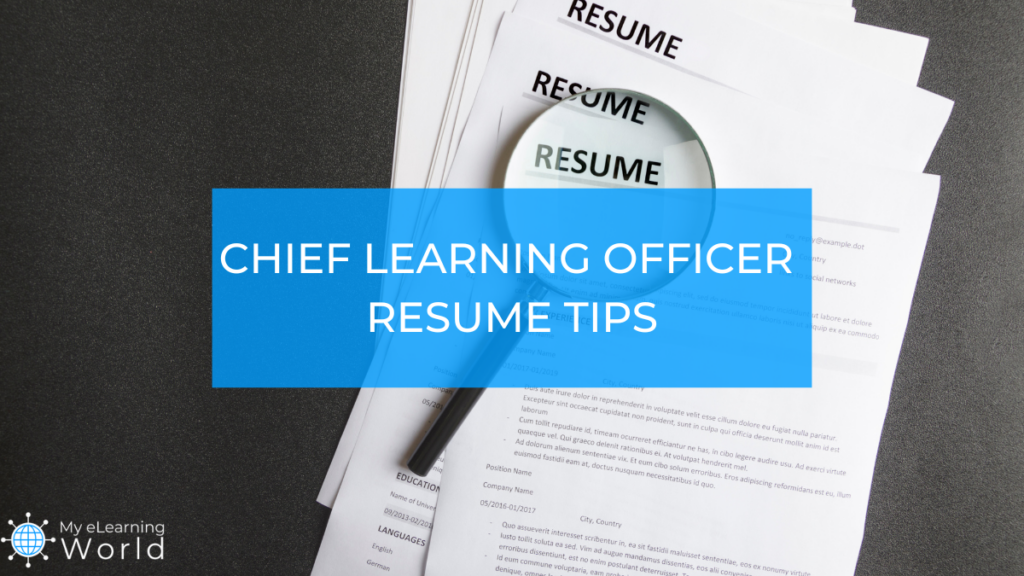A well-structured chief learning officer resume can showcase your skills and help you stand apart from other applicants so you can increase your chances of getting the job you want.
A resume is often the first impression an employer will have of you, so it is important to make sure it is well-written and free of any errors.
Simply put, the goal of your chief learning officer resume should be to make a lasting impression and to demonstrate why you are the best candidate for the CLO position.
And while there are some resume best practices you probably already know, like keeping it clear and concise as well as free of any errors, there are some less obvious things you should be aware of when putting together your CLO resume.
In the guide below, we will go over some chief learning officer resume tips to help you create the perfect asset that will help you get the job you want.
Editor’s Note: Did you know Resumeble offers professional resume reviews and resume writing services by their team of professionals? It’s a great way to make sure your chief learning officer resume is the best it can be. Click here to get your resume review.
What to Include in Your Chief Learning Officer Resume
Before we go into specific tips for improving your CLO resume, let’s go over some of the different key elements you need to make sure are represented in this document.
Contact Information
When deciding what contact information to include on your professional resume, there are a few things to keep in mind.
First, make sure that your contact information is up-to-date and accurate.
Secondly, only include information that you are comfortable sharing with potential employers. For example, your email address should be professional and easy to remember. You may also want to include your LinkedIn profile or other online portfolios.
Finally, be sure to list a way for employers to reach you during business hours.
Including your telephone number or Skype address is generally a good idea.
Personal Information
One of the most common questions people have when writing their professional resume is what personal information to include.
While there are no hard and fast rules, there are a few guidelines you can follow.
First, consider whether the information you want to include is relevant to the job you’re applying for. If it’s not, then leave it off your resume.
Second, think about how the information might be used against you. For example, if you’re applying for a job that requires knowledge of new technologies, disclosing your age may hurt your chances of being hired if you’re older.
Finally, remember that you’re not required to include any personal information on your resume if you don’t want to. If you’re concerned about discrimination or feel like you need to hide something, you can leave this section off entirely.
Ultimately, the decision of what personal information to include on your resume is up to you. Use your best judgment to decide what’s appropriate for the job and for your specific situation.
Experience
A chief learning officer (CLO) is responsible for overseeing an organization’s educational and training programs. So, when crafting your CLO resume, it’s important to highlight your experience in designing, developing, and implementing educational programs.
Do you have classroom experience as a teacher? Make sure to include that.
Have you worked on the administration side of things? Include that too as that’s important experience for chief learning officers to have.
What learning management systems have you worked with? Make sure that’s on there too.
You should also focus on your ability to manage staff and resources, as well as your experience in evaluating the effectiveness of educational programs.
By highlighting your relevant experience and skills, you can demonstrate to potential employers that you have what it takes to be an effective CLO.
Skills
In order to be successful in this role, you will need to have excellent communication and interpersonal skills, as well as experience in curriculum design and adult learning principles.
Additionally, it is important that you have a strong understanding of the latest trends in learning and development.
Therefore, it is essential that your resume demonstrates your expertise in this area.
Some specific skills to highlight might include instructional design, curriculum development, training program management, and adult education principles.
In addition, be sure to showcase your ability to identify training needs to improve organizational performance, develop creative solutions, and evaluate the effectiveness of programs.
Lastly, you should ideally be able to showcase any management skills you have as the CLO is a key member of the executive leadership team who needs to be able to lead and manage others. These could include communication, delegation, problem-solving, and conflict-resolution skills.
Ultimately, your goal is to show potential employers that you have the knowledge and experience necessary to help their organization meet its learning and development goals.
By doing so, you will increase your chances of landing an interview and ultimately the job.
Education, Awards, & Credentials
When writing a resume for a job as a chief learning officer, it is essential to highlight your educational background. As a senior executive responsible for shaping an organization’s learning strategies and initiatives, your educational qualifications can lend weight to your ability to drive transformation and innovation in the learning landscape.
A strong education (ideally at least a bachelor’s degree or, even better, a master’s) will demonstrate your knowledge and expertise in the field, and your ability to collaborate effectively with others.
In addition, many employers look for candidates who have earned advanced degrees or certifications in learning and development, as this can be an indicator of skill and dedication.
Including details about your educational achievements not only establishes your credibility but also showcases your commitment to continuous learning – a vital trait for anyone leading a learning-focused team.
To best showcase your education on your resume, you should structure it according to industry standards, including relevant coursework and any relevant internships or leadership positions.
Highlight your degrees, relevant certifications, and any advanced training that demonstrates your mastery of instructional design, curriculum development, and adult learning principles.
Additionally, you can write about any accolades or awards that you have received during your studies, highlighting your strengths and abilities.
Whether you are looking to move up within the field of learning and development, or are interested in transitioning into this exciting career path from another industry, conveying your educational background clearly on your resume will help you stand out from the crowd.
5 Steps for Creating a Great Chief Learning Officer Resume
Put yourself in the shoes of the hiring manager who has to read dozens upon dozens of resumes.
How can you make yours stand out so that they remember your name when it comes time to interview candidates?
Here are a few tips:
1. Tailor it to fit the job description
When it comes to your chief learning officer resume, one of the most important things to keep in mind is that it should be tailored to the specific CLO position you are applying for.
Why? Because each CLO role comes with unique expectations, organizational needs, and industry nuances that demand a tailored approach.
By crafting a resume that aligns precisely with the job description and company culture, you demonstrate a keen understanding of the role and an unwavering commitment to delivering value.
This means more than simply ensuring that your resume contains the required chief learning officer skills.
It also means taking the time to read through the job posting and determine what the specific needs and requirements are for that particular CLO role. For instance, they might mention that they’re looking for candidates with experience using particular learning management systems.
Once you have a good understanding of what the company is looking for, you can then focus on highlighting your own relevant skills, experience, and accomplishments as they relate to the company’s specific job description.
By customizing your resume in this way, you are much more likely to catch the attention of the hiring manager and increase your chances of being called in for an interview. This personalized approach really resonates with hiring managers, indicating that you’ve taken the time to deeply understand their needs and that you possess the skills and insights to drive success in their learning initiatives.
2. Use simple formatting
In most cases, you’ll be sending your email either as an email attachment or as an upload on the company’s website.
With that in mind, you want to make sure their applicant tracking system can easily scan through your chief learning officer resume.
Often times, your resume will pass through a tracking system before it even has the chance to reach a real human.
That’s why I often recommend formatting your resume in plain text rather than using more elaborate designs.
Plain text ensures that your resume will be able to be read by the system and that all of your important information will be included.
3. Use the right keywords in your resume
Remember how I said many employers use applicant tracking systems to scan resumes?
That means it’s important for your chief learning officer resume to include the right words and phrases for it to get picked up and flagged as relevant.
Some of the most important keywords to include are those related to chief learning officer responsibilities, such as “learning initiatives,” “performance management,” “leadership development,” “employee development,” “organizational development,” or “training programs.”
Again, this is where looking at the job posting and description can be helpful. You can use the keywords and phrases that are listed in the posting to make sure your resume is as relevant and targeted as possible.
Make sure to sprinkle them throughout your resume, including in your skills section, work experience section, and anywhere else that seems relevant.
4. Highlight your accomplishments and the impact of your work
When it comes to writing a chief learning officer resume, one of the most important things to focus on is your accomplishments.
What have you done in your previous roles that have made a positive impact on the company or overall organizational performance?
Be specific.
Instead of just saying, “I created a training program for a company,” you might say, “I developed a corporate training program that improved employee productivity by 75% and improved profits by 60%.”
The more specific and quantitative your accomplishments are, the better.
Focus on those that are most relevant to the CLO position you are applying for and that will give the hiring manager a good sense of the value you can bring to their company.
5. Use strong language and action verbs
The best chief learning officer resumes use language that is both powerful and concise.
Choose your words carefully and avoid using any fluffy or unnecessary language.
It’s also important to use action verbs throughout your resume to really convey the impact of your work.
Some examples of strong action verbs include “developed,” “created,” ” oversaw,” “managed,” and “implemented.”
Using these types of verbs will help paint a picture of your chief learning officer responsibilities and accomplishments in a way that is clear and concise.
Useful Resources
- How to become a chief learning officer
- What is a chief learning officer?
- What’s the average chief learning officer salary?
- Chief Learning Officer Magazine
A Final Word on Chief Learning Officer Resumes
Your resume is your opportunity to make a good first impression on potential employers, and you only get one chance to make the right first impression.
A well-crafted resume can be the difference between getting an interview or being passed over for a job.
By following these tactics used in the best chief learning officer resumes, you can be sure that your resume will stand out from the rest and that you’ll be one step closer to landing your dream job.
But remember, with how easy it is these days to submit job applications online, you might be competing with hundreds of job seekers.
One way you can stand out from the pack is by taking courses to upgrade your skills.
Personally, I encourage all aspiring eLearning professionals to look into the Professional Certificate in Instructional Design program from Emeritus – it’s the perfect crash course. In just five months, you’ll learn foundational eLearning design theories and practical tips for designing effective learning experiences. Don’t miss out on this invaluable opportunity!
You can learn more about the program and request a brochure at this link.
 Emeritus Professional Instructional Design Certificate | Online Certificate Course
Emeritus Professional Instructional Design Certificate | Online Certificate Course
Gain firsthand expertise in instructional design principles and methodologies through this unique Professional Certificate program. Create impactful learning solutions and improve people's ability to learn.
Have any questions about how to create a chief learning officer resume? Leave a comment below.


